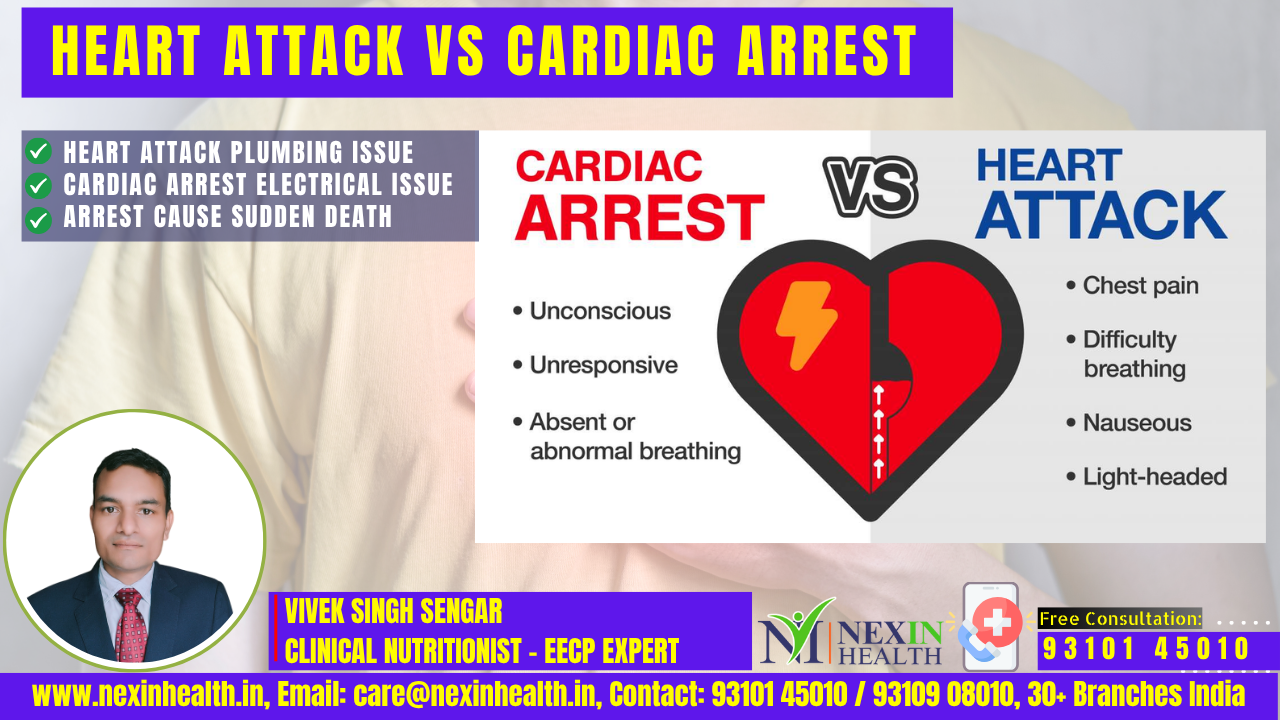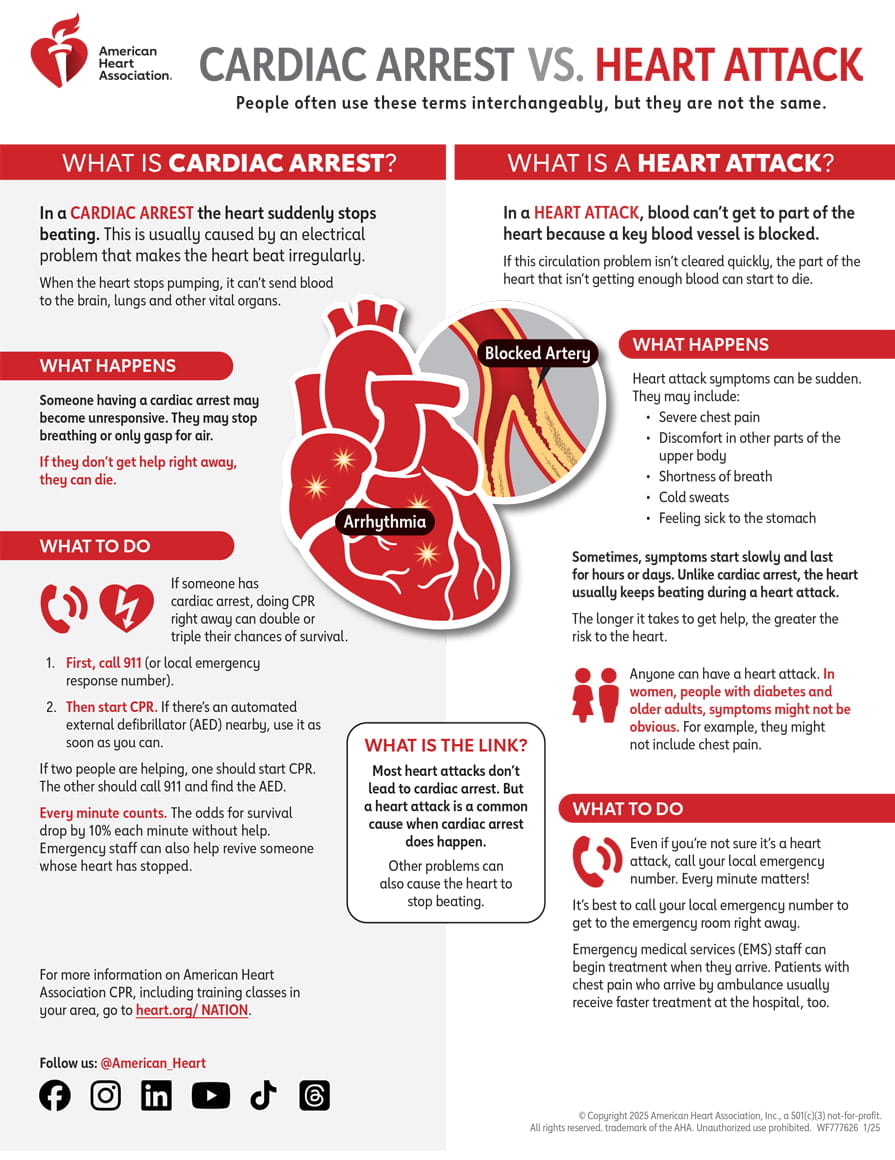Heart Attack vs Cardiac Arrest: What’s the Real Difference?


Heart Attack vs Cardiac Arrest: It was a regular Tuesday morning when 42-year-old Mumbai executive Rajesh Kumar collapsed in his office elevator. His colleagues, panicking, kept saying “he’s having a heart attack” as they rushed him to the hospital. But what Rajesh actually experienced was sudden cardiac arrest – a completely different, though equally dangerous, medical emergency. This confusion between heart attack vs cardiac arrest isn’t just common among the general public; it’s a potentially life-threatening misunderstanding that affects millions of families across our country.
While both conditions involve the heart and can be fatal without immediate intervention, understanding the crucial differences between these cardiac emergencies could be the key to saving a life – perhaps even your own or that of a loved one.

Before diving deeper into the differences, here are some startling facts about cardiac emergencies that might shock you:
The fundamental distinction between these two cardiac emergencies lies in their underlying mechanisms. Heart attack vs cardiac arrest represents two entirely different problems within the cardiovascular system.
A heart attack, medically termed myocardial infarction, is primarily a circulation problem. Think of your heart as a hardworking muscle that needs constant oxygen supply through blood vessels called coronary arteries. When one of these arteries becomes blocked – usually by a blood clot or fatty plaque buildup – part of the heart muscle begins to die from lack of oxygen.
The blocked artery creates a domino effect. The heart muscle supplied by that artery starts deteriorating, but the heart typically continues beating. This is why many heart attack patients remain conscious and can communicate, though they experience severe symptoms.
Cardiac arrest, on the other hand, is an electrical problem. Your heart has its own electrical system that controls the rhythm and timing of heartbeats. During cardiac arrest, this electrical system malfunctions, causing the heart to stop beating effectively or stop altogether.
When cardiac arrest occurs, blood flow to the brain and other vital organs ceases immediately. The person loses consciousness within seconds and stops breathing normally. Without immediate intervention, death occurs within minutes.

Heart attack symptoms often develop gradually and may persist for hours or even days. Common warning signs include:
Classic Symptoms:
Atypical Presentations: Many people, especially women and diabetics, experience atypical heart attack symptoms:
Cardiac arrest symptoms are dramatically different and develop instantly:
Before collapse, some people may experience brief warning signs like chest pain, shortness of breath, weakness, or fast-beating heart, but these are not always present.
Heart attacks typically result from coronary artery disease, where fatty deposits (plaques) build up in coronary arteries over time. Risk factors contributing to this process include:
While heart attacks can lead to cardiac arrest, many other factors can trigger this electrical malfunction:
Heart attack treatment focuses on quickly restoring blood flow to the affected heart muscle. Modern cardiovascular medicine offers several proven interventions:
Immediate Medications:
Advanced Procedures:
Cardiac arrest treatment is all about immediate action. The survival chain includes:
Immediate Response:
Professional Treatment:
Dietary Modifications:
Physical Activity:
Risk Factor Management:
While cardiac arrest can be less predictable, certain strategies help:
Understanding the relationship between these conditions is crucial. Heart attacks increase the risk for sudden cardiac arrest, and this connection explains why rapid heart attack treatment is so critical.
During a heart attack, the damaged heart muscle can develop dangerous electrical instability. If a large portion of the heart muscle is affected, the heart’s electrical system may fail, leading to cardiac arrest. This is why emergency departments prioritize heart attack patients and why “time is muscle” in cardiac care.
Recent clinical studies suggest that approximately 15-20% of heart attacks may progress to cardiac arrest, particularly when treatment is delayed or when the heart attack is extensive.
Heart attack survivors typically face a structured recovery process:
Immediate Recovery (First Few Days):
Long-term Management:
Worldover, the rates of survival among the general population post a sudden cardiac arrest is something like 10 per cent, making it one of the most challenging medical emergencies to survive.
Survivors often face:
When someone shows heart attack symptoms:
For cardiac arrest situations:
Modern medical technology has revolutionized cardiac emergency care:
Diagnostic Advances:
Treatment Innovations:
Creating heart-healthy communities requires collective effort:
Educational Programs:
Infrastructure Development:
Que: Can a person have both a heart attack and cardiac arrest simultaneously?
Ans: Yes, a heart attack can trigger cardiac arrest, especially if a large portion of heart muscle is damaged. However, they are distinct conditions with different underlying causes and treatments.
Que: How quickly should someone seek medical attention for chest pain?
Ans: Any chest pain lasting more than 15 minutes, especially with other symptoms like shortness of breath, sweating, or nausea, requires immediate emergency medical attention.
Que: Are there any early warning signs for cardiac arrest?
Ans: While cardiac arrest often occurs suddenly, some people may experience chest pain, rapid heartbeat, dizziness, or shortness of breath in the minutes before collapse.
Que: Can young, healthy people experience cardiac arrest?
Ans: Yes, cardiac arrest can affect people of any age, including young athletes and apparently healthy individuals, often due to undiagnosed heart conditions or genetic factors.
Que: What’s the difference between cardiac arrest and heart failure?
Ans: Heart failure is a chronic condition where the heart can’t pump blood effectively, while cardiac arrest is an acute emergency where the heart stops beating entirely.
Que: How effective is CPR in saving lives during cardiac arrest?
Ans: When performed immediately, CPR can double or triple survival chances from cardiac arrest, though overall survival rates remain around 10% globally.
Que: Can medications prevent cardiac arrest?
Ans: While medications can’t completely prevent cardiac arrest, they can manage underlying conditions like heart rhythm disorders and reduce risk factors.
Que: What should I do if someone collapses but is still breathing?
Ans: If the person is breathing and has a pulse, place them in the recovery position, call for medical help, and monitor their vital signs until help arrives.
Que: How long can someone survive cardiac arrest without treatment?
Ans: Without immediate CPR, survival chances decrease by 7-10% every minute. After 10 minutes without treatment, survival becomes extremely unlikely.
Que: Are there genetic factors that increase cardiac arrest risk?
Ans: Yes, certain genetic conditions affecting heart rhythm and structure can significantly increase cardiac arrest risk, making family history important for risk assessment.
Understanding the critical differences between heart attack and cardiac arrest empowers you to respond appropriately in emergencies and take preventive measures for long-term heart health. Remember, both conditions require immediate medical attention, but your response can make the difference between life and death.
Also Read:
EECP Treatment for Heart Failure
Track Heart Failure with 6 Minute Walk Test
_____________________________________________________________________________
Mr. Vivek Singh Sengar is the Founder of Fit My Heart and a leading Integrated Health Practitioner & Clinical Nutritionist at NEXIN HEALTH and MD City Hospital Noida. With over 13 years of experience, Vivek has treated more than 25,000 patients suffering from lifestyle diseases like heart disease, diabetes, and obesity through non-invasive, drugless, and nutrition-focused therapies.
His expertise combines modern medical knowledge with traditional Indian healing practices to provide comprehensive care for heart failure patients. Vivek’s approach focuses on sustainable lifestyle modifications, nutritional therapy, and patient education to achieve optimal cardiovascular health outcomes.
Get Expert Guidance for Your Heart Health:
📧 Email: care@nexinhealth.in
📞 Phone: +91 93101 45010
💬 WhatsApp: Click to Chat
Take the first step towards better heart health today. Contact our team for personalized heart failure management plans tailored to your specific needs and lifestyle.